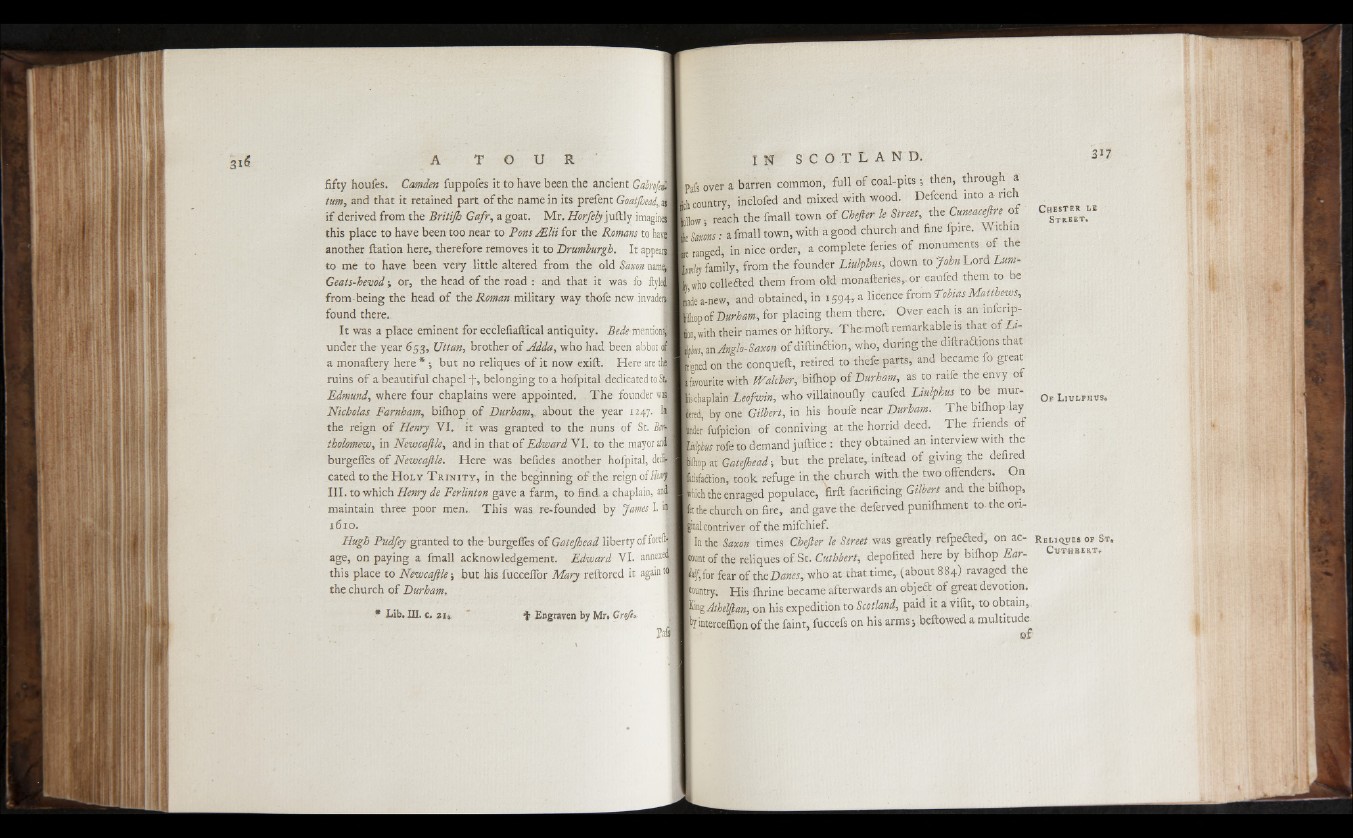
fifty houfes. Camden fuppofes it to have been the ancient GalroJiA
turn, and that it retained part of the name in its prefent Goatjheai, ajj
if derived from the Britijh Gafr, a goat. Mr. HorfelyjuMy imagini
this place to have been too near to Pons AElii for the Romans to havl
another ftation here, therefore removes it to Drumburgh. It appeaJ
to me to have been very little altered from the old Saxon nam«
Geats-hevod; or, the head of the road : and that it was fo ftyle®
from-being the head of the A«»«« military way thofe new invadel
found there»
It was a place eminent for ecclefiafiical antiquity. Bede mention#
under the year 653, Uttan, brother o f Adda, who had been abbot eft
a monaftery here * •, but no reliques of it now exift. Here are th|
ruins of a beautiful chapel -]-, belonging to a hofpital dedicated to Si
Edmund, where four chaplains were appointed. The founder wal
Nicholas Farnham, bilhop of Durhamabout the year 1247. ia l
the reign of Henry VI. it was granted to the nuns of St. Bsm
tholomew, in Newcajlle, and in that of Edward VI. to the mayor ani
burgefies of Newcajllea Here was befides another hofpital, de®
cated to the H oly T r i n i t y , in the beginning of the reign of Ham
III. to which Henry de Ferlinton gave a farm, to find, a chaplain, an®
maintain three poor men. This was re-founded by James I. dj
1610.
Hugh Pudfey granted to the burgefies of Gatejhead liberty of ford®
age, on paying a fmall acknowledgement. Edward VI. annexe®
this place to Newcajlle; but his fuccefibr Mary reftored it again tfl
the church of Durham.
* Lib. III. c. 21, t Engraven by Mr. Crofi,.
Ipafs over a barren common, full of coal-pits; then, through a
Ich country, inclofed and mixed with wood. Defcend mto a rich
t o w reach the fmall town of Chejler le Street, the Cuneacejlreof
Ke Sams: a fmall town, with a good church and fine fpire. Withm
l e ranged, in nice order, a complete feries of monuments of the
Li/n family, from the founder Liulphus, down to John Lord Lum-
t who collected them from old monafteries,.or caufed them to be
l i 1» a new, and obtained,, in 1594, a licence from Fobias Matthews,
■ilhopof Durham, for placing them there. Over each is an nti iq*
Ion with their names or hiftory. Thermoft remarkable is that of U -
| i an Anglo-Saxon of diftinaibn, who, during the diftradions that
Eme’d on the conqueft, retired to thefe parts, and became fo great
I ¡¡favourite with Walcher, bilhop of Durham, as to raife the envy of
■is chaplain Leofwin, who villainouily caufed Liulphus to be mur-
B r e d , by one Gilbert, in his houfe near Durham. The bifhoplay
Binder fufpicion of conniving at the horrid deed. The friends of
f c t e rofe to demand juftice : they obtained an interview with the
Bilhop at Gatejhead but the prelate,.inftead of giving the defired
T h s f a & o t v »ok refuge in the church with the two offenders^ On
hich the enraged populace, firlt facrificing Gilbert and the bilhop,
It the church on fire, and gave the deferved punilhment to-theon-
|inal contriver of themifchief.
In the Saxon times Chejler le Street was greatly refpeited, on ac-
fiount of the reliques of. St. Cuthbert, depofited here by bilhop Ear-
K for fear of the Danes, who at that time, (about 884) ravaged the
puntry. His Ihrine became afterwards an objeft of great devotion,
ping Athelfian, on his expedition to Scotland, paid it a vifit,-to obtain,,
pyintercefiionofthe faint, fuccefs on his armsj beftowed a multitude
of
C h e s t e r l e
S t r e e t .
O f L i u l p h o s .
R b l iq u e s o f S t ,
C u t h b e r t ,